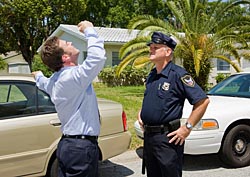Finger-to-Nose Stand Field Sobriety Test
 |
|---|
One final non-standardized field sobriety test that is used by police officers is the finger-to-nose test. Even though this test dates back to the 1950s, it is still used today to determine if a driver is under the influence of drugs or alcohol. Because it is non-standardized, the finger-to-nose field sobriety test is not endorsed by the National Highway Traffic Safety Administration (NHTSA). That is to say, the finger-to-nose field sobriety test failed to meet the standardization requirements of the NHTSA.
The finger-to-nose field sobriety test is a divided attention test that requires you to divide your attention between a mental task and a physical task. In administering this test, the police officer will instruct you to stand with you feet together with your hands at your side and remain still. You will also be instructed to close your eyes and keep your head facing forward. The police officer will then begin to give directional commands. That is to say, the police officer will either state “right” or “left” and you will be required to touch the corresponding tip of your index finger to the tip of your nose while maintaining your balance with your eyes closed. Typically, the sequence that most police officers utilize is left, right, left, right, right, left. Not surprisingly, most people detect the pattern of alternating sides and are confused by the two consecutive “right” commands.
Just like other field sobriety tests—non-standardized field sobriety tests, in particular—the finger-to-nose test is criticized as invalid, inaccurate and designed to fail. In fact, many sober people are unable to touch the tip of their index finger to the tip of their nose with their eyes closed. Additionally, there is no list of indicators of impairment for this test. That is to say, the determination of whether or not your performance indicates that you are under the influence of drugs or alcohol is based solely upon the police officer’s subjective analysis of your test results. The test results can easily be skewed by any bias or preconceived opinion that the police officer may have regarding whether you are sober or intoxicated.